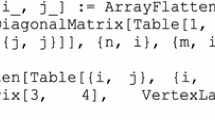Abstract
This paper introduces a visual framework in the environment of a computer algebra system for displaying interregional trading patterns in multi-region, multi-activity economies. Interregional input–output tables illustrate spatial and economic interdependencies within interregional trade and are considered a key component in input–output modeling. The study and analysis of the interregional trade flows in interregional economic activities often reveal interregional and inter-activity linkages, referred to as “feedback loops” and/or spatial production cycles in interregional level. Trade theory considering feedback loops is a relatively new approach to the detailed analysis of vertical specialization of trade flows. This approach leads to the decomposition of global trade into feedback loops. Given the analysis of interregional inter-activity feedback loops based on the trade flows data, interregional input–output tables and associated trading patterns can be depicted using programmed functions in MATHEMATICA. Our programmed functions create static and dynamic images presenting the structure and the intensity of feedback loops connecting the regions and the activities of an economy. The generated visual schemes succeed to picture the multilateral trade connections between all regions. The programming codes along with their application in examples from the relevant literature are our methodological contribution in the visualization of trading tables.











Similar content being viewed by others
Notes
Mathematica software is tradable from Wolfram Research, Inc.
We make the assumption that all trading partners interact with each other.
In MATHEMATICA’s internal representation, each block is defined as a matrix of indices with values varying from 0 to 1. Indices within the range [0.1–0.4] denote a weak interaction between trade partners; as the index approaches 1, the corresponding trading interaction is considered dominant.
References
Alkemade, F., Amman, H., & La Poutre, J., A. (2002). The Role of Information in an Electronic Trade Network. Computing in Economics and Finance, 376, Society for Computational Economics. Accessed from: http://ideas.repec.org/p/sce/scecf2/376.html.
Alkemade, F., La Poutré, J., & Amman, H. (2003). An agent—Based evolutionary trade network simulation. In A. Nagurney (Ed.), Innovations in financial and economic networks (pp. 237–252). Northampton, MA: Edward Elgar Publishers.
Amman, H., Alkemade, F., & La Poutre, H. (2003). Intermediaries in an Electronic Trade Network. Computing in Economics and Finance, 6, Society for Computational Economics. Accessed from: https://ideas.repec.org/p/sce/scecf3/6.html.
Batten, D., & Martellato, D. (1985). Classical versus modern approaches to interregional input–output analysis. The Annals of Regional Science, 19(3), 1–15. doi:10.1007/BF01294827.
Halkos, G. E., & Tsilika, K. D. (2015). A Dynamic Interface for Trade Pattern Formation in Multi-regional Multi-sectoral Input-Output Modeling. Computational Economics. doi:10.1007/s10614-014-9466-3.
Hitomi, K., Okuyama, Y., Hewings, G. J. D., & Sonis, M. (2000). The role of interregional trade in generating change in the regional economies of Japan, 1980–1990. Economic Systems Research, 12(4), 515–537.
Hitomi, K., Hewings, G. J. D., Yamano, N., & Ohkawara, T. (2002). Hollowing Out Process in Regional Economy: an Interregional input–ouput analysis, CRIEPI REPORT Y01014. Accessed from: http://criepi.denken.or.jp/en/publications/criepi_report/.
McFadzean, D., Stewart, D., & Tesfatsion, L. (2001). A Computational Laboratory for Evolutionary Trade Networks. IEEE Transactions on Evolutionary Computation, 5(5), 546–560. doi:10.1109/4235.956717.
McFadzean, D., & Tesfatsion, L. (1997). An Agent-Based Computational Model for the Evolution of Trade Networks (ps,132KB). In P. Angeline, R. Reynolds, J. McDonnell, & R. Eberhart (Eds.), Evolutionary programming VI, proceedings of the sixth international conference on evolutionary programming (pp. 73–83). Berlin: Springer-Verlag.
McFadzean, D., & Tesfatsion, L. (1999). A C++ platform for the evolution of trade networks. Computational Economics, 14, 109–134.
Munroe, D. K., Hewings, G. J. D., & Guo, D. (2007). The Role of intraindustry trade in interregional trade in the Midwest of the US. In Russel Cooper, Kieran Donaghy, & Geoffrey Hewings (Eds.), Globalization and regional economic modeling, advances in spatial science (pp. 87–105). Berlin Heidelberg: Springer.
Sonis, M., Oosterhaven, J., & Hewings, G. J. D. (1993). Spatial economic structure and structural changes in the EC: Feedback loop input–output analysis. Economic Systems Research, 5(2), 173–184. doi:10.1080/09535319300000016.
Wixted, B., Yamano, N., & Webb, C. (2006). Input–output analysis in an Increasingly Globalised World: Applications of OECD’s Harmonised International Tables. OECD Science, Technology and Industry Working Papers, 2006/07, OECD Publishing. Available at http://dx.doi.org/10.1787/303252313764.
Author information
Authors and Affiliations
Corresponding author
Rights and permissions
About this article
Cite this article
Halkos, G.E., Tsilika, K.D. Trading Structures for Regional Economies in CAS Software. Comput Econ 48, 523–533 (2016). https://doi.org/10.1007/s10614-015-9515-6
Accepted:
Published:
Issue Date:
DOI: https://doi.org/10.1007/s10614-015-9515-6




